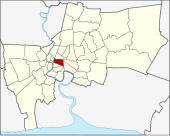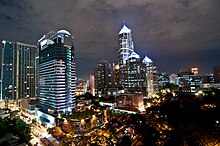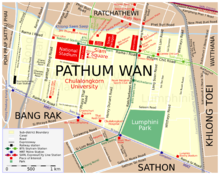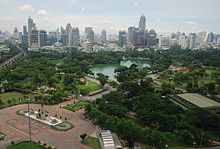Pathum Wan
| Pathum Wan ปทุมวัน |
|
|---|---|
| Data | |
| Province: | Bangkok |
| Surface: | 8.37 km² |
| Residents: | 52,613 (2013) |
| Population density : | 7601.7 U / km² |
| ZIP : | 10330, 10110, 10120, 10500, 10400 |
| Geocode : | 1007 |
| map | |

|
|
| Bangkok boroughs | |
Pathum Wan ( Thai ปทุมวัน ) is one of the 50 districts (Khet) in Bangkok , the capital of Thailand . Pathum Wan is located in the eastern part of the city center. It is bounded in the north by Rama I Street (Thanon Phra Ram 1) and in the south by Rama IV Street (Thanon Phra Ram 4) . It is one of the central business districts of Bangkok.
geography
Pathum Wan is bounded to the north by Khlong Saen Saep , to the east by the Makkasan - Khlong Toei railway line , to the south by Rama IV Street and to the west by Khlong Phadung Krung Kasem .
The neighboring districts are clockwise from the north: Ratchathewi (on the other bank of Khlong Saen Saep ), Watthana , Khlong Toei , Sathon , Bang Rak , Pom Prap Sattru Phai (on the other bank of Khlong Phadung Krung Kasem) and Dusit .
history
Pathum Wan District was established in 1914. At that time it was still largely outside the closed settlement area of Bangkok and was covered by fields and orchards. It is named after Wat Pathum Wanaram (Temple of the Lotus Forest), a Buddhist temple ( Wat ), and the nearby Sra Pathum Palace (Lotus Pond Palace). Both plants go back to an order of King Rama IV (Mongkut). The name goes back to the myriad of lotus blossoms that covered the water at Khlong Saen Saep. King Rama V (Chulalongkorn) had a palace built here in 1881 for his firstborn son Vajirunhis , which was designed by an English architect in the Gothic style and was reminiscent of Windsor Castle . The Crown Prince died early, however, and the facility was handed over to the Civil Service College in 1911, which became Chulalongkorn University , Thailand's first university, in 1917 . This still maintains its main campus in Pathum Wan, which covers almost a quarter of the district with over 200 hectares.
In 1916, in the southwest corner of the district, Hua Lamphong Station , Bangkok's main train station, was inaugurated. King Rama VI. (Vajiravudh) had Lumphini Park laid out in the 1920s , with 57 hectares the largest city park in Bangkok, in which the first public library and the first public dance hall in Bangkok were established. The "Windsor" palace was demolished in 1936 and the Suphachalasai Stadium (national stadium ) was built in its place .
In the 1930s and 40s, the development of Bangkok then grew along the Thanon Phloen Chit and Witthayu ("wireless road") to the east, and the former in particular developed into a shopping and entertainment mile from the 1950s. In 1956 the Grand Hotel Erawan opened at the Ratchaprasong intersection, on the premises of which there is a shrine for the Hindu god Brahma, the so-called Erawan Shrine . This became one of the most revered sanctuaries in the city.
From the mid-1960s, Chulalongkorn University moved the northern section of its land that it did not need for university operations from tenants to small shops, restaurants, tutoring schools, cinemas and the like. that are mainly frequented by students and other younger middle-class members. This area is called Siam Square . However, the university retained ownership of the land and derives part of its income from the lease. Long before Khaosan Road became the center of backpacking tourism in Thailand, even before the first Lonely Planet travel guide for Thailand was published, there was the Thai Song Greet Hotel at the beginning of Rama IV Street near Hua Lamphong Central Station “, Which was very popular with young western individual travelers in the 1960s and 70s.
In 1973, the Siam Center, Bangkok's first modern shopping center, opened. Like the Siam Discovery Center and Siam Paragon that were added later, it is located on property that was originally part of the Sra Pathum Palace and is still part of the crown fortune of the Thai monarchs. The Ma-Bunkhrong Center (MBK) opened in 1985 at the Pathum-Wan intersection (this property also belongs to Chulalongkorn University) was Asia's largest shopping mall at the time. The even larger, eight-story World Trade Center followed in 1990 at Ratchaprasong Junction, now known as Central World . The two lines of the Skytrain , inaugurated in 1997 , Bangkok's first rail-based mass transport system, cross at the Siam stop in Siam Square. Since then, at the latest, and with the construction of further shopping centers, high-rise office buildings and luxury hotels in the 1990s and 2000s, Pathum Wan has assumed a large part of the functions of a city center .
As part of the riots in April and May 2010 , the so-called "red shirts" occupied the area around the Ratchaprasong intersection. After the failure of a negotiated solution, large parts of the Pathum Wan district were declared an area of operation for the military. There were street battles similar to civil wars and entire streets became no-go areas . The Siam Cinema and parts of Central World were burned down at the height of the fighting.
Shopping centers
Pathum Wan is well known for its shopping malls. The oldest of these centers is the Siam Center from 1973, which was later expanded by the Siam Discovery Center and again expanded in December 2005 by the Siam Paragon , the second largest shopping center in Thailand with a business area of 300,000 m².
Another shopping center is the Maboonkrong Center (MBK) that was established in the 1980s . Here you can buy cheap clothes, cell phones and souvenirs. Bonanza Mall is connected to the MBK by a bridge on the other side of Thanon Phayathai (Phayathai Street).
CentralWorld , which opened in 2006 and replaced the former “World Trade Center” from 1990, is the largest shopping center in Thailand with a retail space of 429,500 m². It was set on fire during the "red shirt" riots in May 2010 . It has been completely restored since January 2012.
Siam Square is a different shopping area: It consists of many smaller buildings with many alleys along which the shops are located. It is mostly attended by young people. There were also three traditional cinemas, which had been in existence since the 1960s and 70s: Siam, Lido and Scala (the latter known for its Art Deco style foyer ). Siam was completely burned down during the "red shirt" riots in May 2010 and was not subsequently rebuilt. Lido and Scala are still regarded as nostalgic traditional cinemas which, unlike the large multiplex cinemas, not only show "blockbusters", but also independent films . However, according to plans by the landowner (Chulalongkorn University), the Lido is also to be closed to make way for another shopping center. In addition to the shops, there are also numerous tutoring schools here that prepare for the national exams, so that many students commute here during the evenings and on the weekends.
Until 2011, the night market " Suan Lum " (Suan Lum Night Bazaar) was located next to Lumphini Park . It was located in the open air on the site of a former military school and mainly sold clothes and souvenirs. Some restaurants and a beer garden with a tent roof and live music were also available. Inside the bazaar there were performances in the evenings by the Joe Louis Theater , which shows the traditional Thai puppets. In 2006 the landowner, the Crown Property Bureau , decided not to extend the lease and instead to develop the area into office buildings, apartment complexes or a shopping center. Instead, an alternative location for the night market is to be built many kilometers further north on Ratchadaphisek Street in the Chatuchak district .
Other major shopping venues include: Big C, Narayana Phan, Sogo Department Store, Gaysorn Plaza, Central Chitlom, Central Embassy and Siam Square One.
Attractions
The Lumphini Park ( สวน ลุ ม พิ นึ , Suan Lumphini) is the "green lung" of Pathum Wan. Its name is derived from the Buddha's birthplace . There are two lakes in the park that are ideal for boating. After dawn you can watch many people doing their tai chi exercises here. At the weekend you can borrow bast mats, on which you can relax on the banks of the lakes. Numerous cookshops then offer their goods for sale. West of the park is the Lumpini Boxing Stadium, where the traditional Thai boxing is listed. To the northeast of Lumphini Park is also a horse racing track , the Royal Bangkok Sports Club. Horse races take place here on Saturdays.
A larger area of the Pathum Wan district is occupied by several organizations: In addition to the MBK Center, this is Chulalongkorn University , the oldest university in Thailand. The Museum of Imaging Technologies is located in the Faculty of Science and houses a large collection of old and modern cameras . Right next to the university is the Chulalongkorn Hospital and the Red Cross Thailand (Thai Red Cross). A snake farm, the Queen Saovabha Memorial Institute (Sathan Saovabha) , is open to the Red Cross site . Here one shows, among other things, how the snake venom is removed and develops antidotes to the snake venom, see Saovabha Institute .
One of the main attractions of Pathum Wan is the Jim Thompson House . It forms a complex of beautiful wooden houses in the old Thai style. This is where James HW Thompson lived , an American entrepreneur who revived the Thai silk industry and made it known in the West. It's a museum now.
The Bangkok Art and Culture Center is located on the corner of Rama I Street (Thanon Phra Ram 1) and Phayathai Street (Thanon Phayathai), and has been showing changing exhibitions of contemporary art since it opened in July 2008.
The Erawan Shrine is a sacred place where many people come together to pray and express their wishes for the future. You bring back flowers, wooden elephants or other objects if your wish has come true. In this case, you can also perform a traditional dance. Wishes relate to work, family, travel, successful exams, etc.
The district is also home to the National Stadium ( Suphachalasai Stadium ), which was Thailand's national stadium until 1998.
With the Centara Grand Hotel (235 m) and the CRC (China Resources) Tower (210 m), two of the tallest buildings in Bangkok are located in this district.
traffic
Hua Lamphong is the main train station of Bangkok. Here the trains go in all directions within Thailand.
Both of Bangkok's major mass transit modes serve the Pathum Wan district. The Bangkok Metro (MRT) has stations in Hua Lamphong, Sam Yan, Si Lom and Lumphini along the southern district border.
Siam Station on the Bangkok Skytrain (BTS) serves as a transfer station between the Si Lom Line and the Sukhumvit Line. Other stations in Pathum Wan are: National Stadium and Ratchadamri (Si Lom Line) and Chit Lom and Ploen Chit (Sukhumvit Line).
Speedboats on the Khlong Saen Saep Canal operate on the borough's northern border. Pratu Nam Pier (on Ratchadamri Street, near Central World) is the central station of the waterbus network. From here the western line goes to the Phan Fa Bridge in the Pom Prap Sattru Phai district (near Golden Mount in the northeastern part of Bangkok's old town) and the eastern line goes to Wat Si Bunrueang in the northeastern Bang Kapi district . Pathum Wan Junction (Siam Discovery, MBK, Bangkok Art and Culture Center) is accessible from Hua Chang Pier (first stop on the western line), Jim Thomson's house from Ban Krua Nuea Pier (West 2).
education
Pathum Wan is home to the main campus of Chulalongkorn University , the oldest university in Thailand. In addition, the Technical University of Rajamangala Tawan-ok maintains a secondary campus called Uthenthawai.
administration
The district is divided into four sub-districts ( Khwaeng ) :
| No. | Name Khwaeng | Thai | Pop. |
|---|---|---|---|
| 1. | Rong Mueang | รองเมือง | 18,558 |
| 2. | Wang Mai | วัง ใหม่ | 8,472 |
| 3. | Pathum Wan | ปทุมวัน | 6.252 |
| 4th | Lumphini | ลุ ม พิ นี | 19,331 |
Web links
- Pathum Wan Administration website (in Thai)
- Jim Thompson House - Museum of Traditional Architecture of Thailand
Individual evidence
- ↑ Maurizio Peleggi: Thailand. The Worldly Kingdom. Reaction Books, London 2007, p. 34.
- ↑ Thai Song Greet Hotel 1980 - OldBangkok.com site about a legendary Horel (in English)
- ↑ Lido Theater to be razed for new retail area. In: Bangkok Post , March 14, 2012.
- ↑ 2013 population statistics ( Thai ) Department of Provincial Administration. Retrieved August 5, 2014.
Coordinates: 13 ° 44 ' N , 100 ° 31' E












